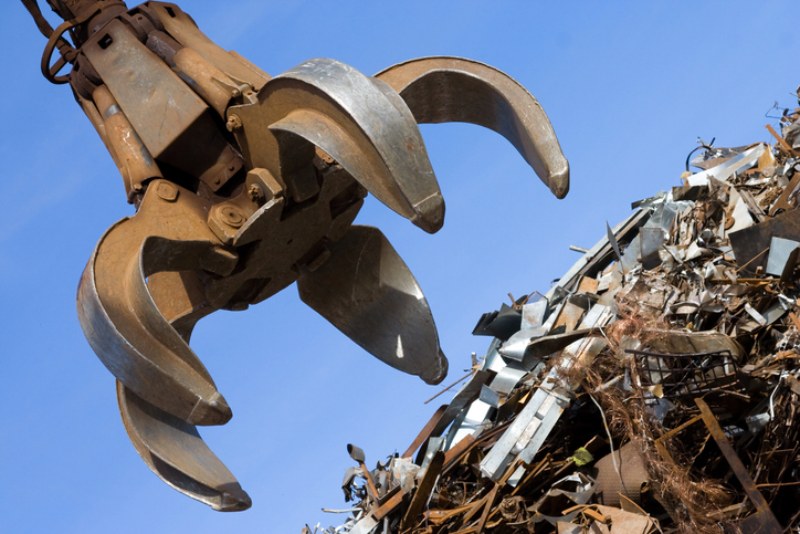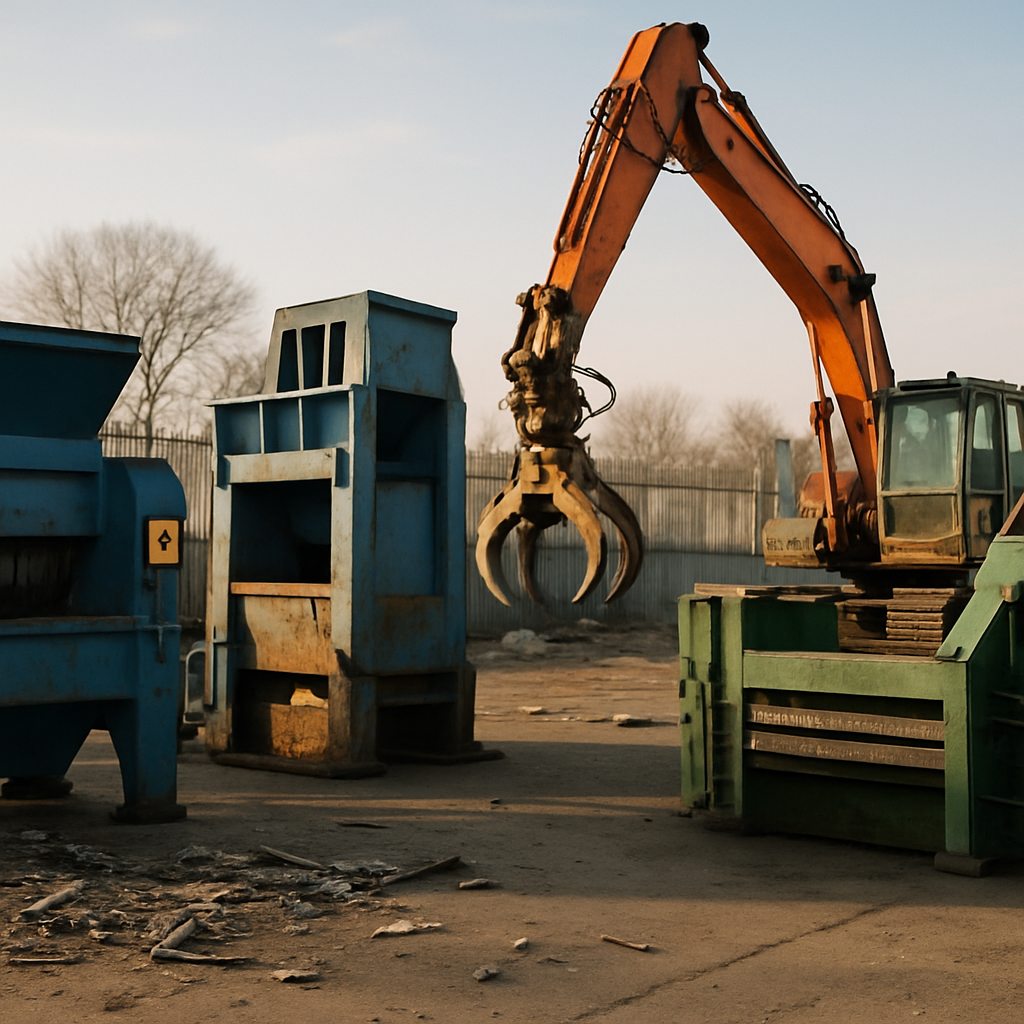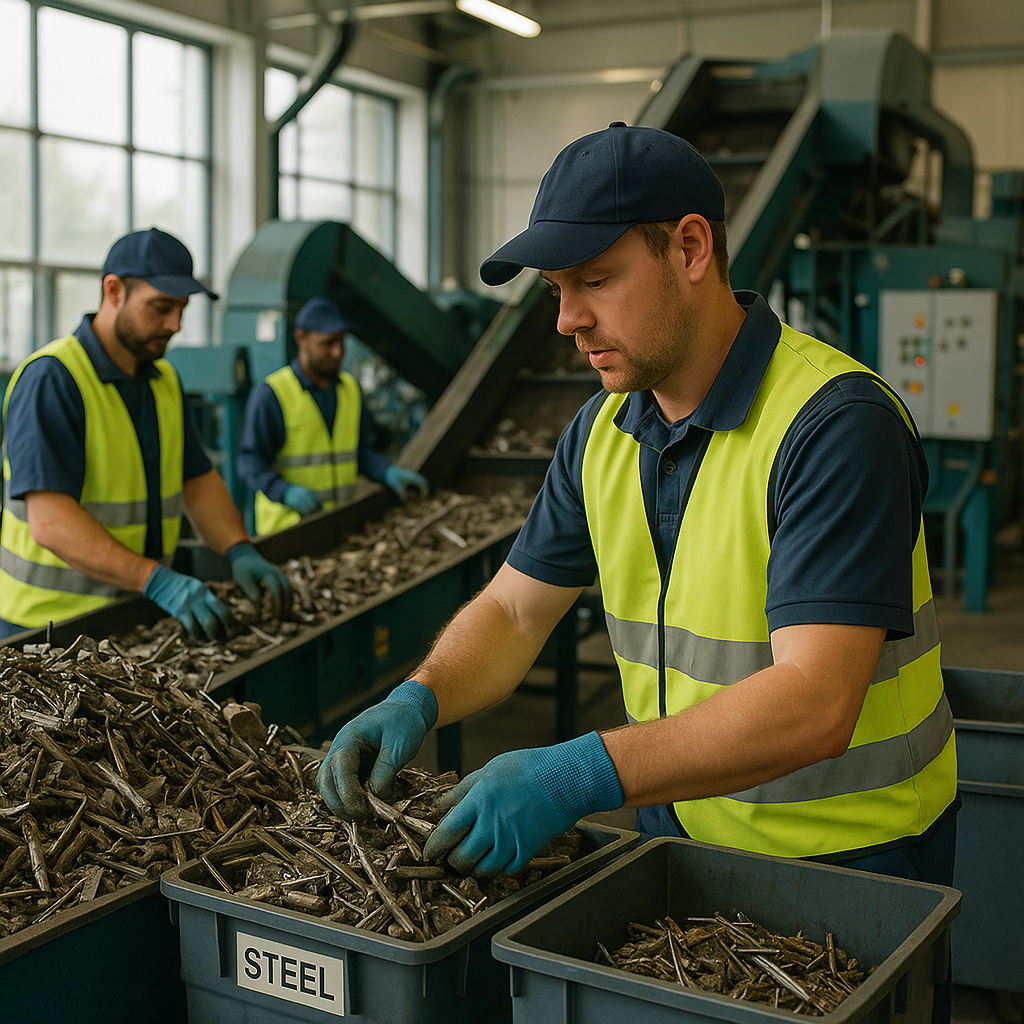5901 Botham Jean Blvd, Dallas, TX 75215
What is Scrap Machinery? Key Types and Benefits
June 28, 2025The foundation of effective recycling operations lies in specialized industrial equipment designed to transform waste into valuable resources. Scrap machinery consists of robust industrial equipment used in recycling facilities to process, sort, and reclaim materials that would otherwise end up in landfills.
These powerful machines form the backbone of modern waste management systems. The category includes various specialized equipment like balers that compress recyclable materials into manageable blocks, industrial shredders that break down materials into smaller particles, and hydraulic shears that cut metal into processable pieces. Other common types include crushers for volume reduction, choppers for size uniformity, and magnetic separators that efficiently sort ferrous from non-ferrous metals.
The role of scrap machinery extends beyond simple waste processing. These sophisticated systems enable recycling plants to streamline operations, maximize material recovery, and contribute significantly to the circular economy. By efficiently processing everything from metal and paper to plastics and electronic waste, scrap machinery serves as a crucial link between discarded materials and their transformation into reusable resources.
What Are the Main Types of Scrap Machinery?

The scrap recycling industry relies on specialized equipment to process materials efficiently. Each machine serves a distinct purpose in the recycling workflow, helping operations maximize material recovery and value.
Balers
Balers compress recyclable materials into dense blocks for easy transport and storage. Horizontal balers handle high-volume operations with continuous feeding, while vertical balers are suitable for smaller facilities with limited space.
Mobile balers offer flexibility for changing locations or remote operations and are essential for processing metals, cardboard, paper, and certain plastics. A typical baler can reduce material volume by up to 90%.
Shredders
Shredders tear materials into smaller pieces to aid sorting and processing. Types include hammer mills for ferrous metals and rotary shears for mixed materials. Twin-shaft models can tackle tough items like car bodies and appliances.
These machines break complex items into component materials. Modern shredders feature advanced controls to optimize performance based on input material. Facilities often use shredders as the first step in a multi-stage recycling process.
Crushers
Crushers reduce the size of bulky items through compaction and breakage. Car crushers flatten entire vehicles to improve transport efficiency, while can crushers densify aluminum and steel containers.
These machines reduce volume while maintaining material integrity. Crushers are crucial in metal recycling, preparing materials for shredding or melting. They help facilities manage large scrap quantities efficiently.
Choppers
Choppers cut materials into uniform pieces for further processing. Wire choppers specifically handle cables, separating metal from insulation using rotating blades for consistent output.
Choppers are vital for processing electrical wires and cables, aiding in the recovery of valuable copper and aluminum from insulated products. The uniform output from choppers enhances downstream separation efficiency.
Shears
Shears cut heavy materials that other equipment cannot manage. Alligator shears use a hinged jaw for thick metals, while guillotine shears employ a straight blade for precise cuts.
Hydraulic shears provide significant cutting force for tough applications, preparing oversized materials for further processing. They are essential for dismantling large structures and heavy equipment.
Magnetic Separators
Magnetic separators isolate ferrous metals from mixed streams using powerful electromagnets or permanent magnets. Configurations include overhead magnets, drum separators, and pulley systems.
These machines are crucial for creating clean material streams, often used at multiple processing stages to ensure high-quality output by removing unwanted ferrous contamination.
Each type of machinery plays a specific role in the recycling chain. Equipment selection depends on the materials processed, volume needs, and available space. Most facilities use multiple machine types in an integrated system.
How Does Scrap Machinery Benefit the Recycling Industry?

Scrap machinery forms the backbone of modern recycling operations. These specialized machines transform potential waste into valuable resources through efficient processing. The technology behind these machines continues to evolve, enhancing the viability and cost-effectiveness of recycling.
Material reclamation is one of the most significant benefits. Scrap press machines facilitate the recovery of valuable metals and other materials that might otherwise end up in landfills. Metal recycling equipment can process industrial wet metal filings, chips, and clippings into compact briquettes with volume reduction ratios of up to 8:1. This transformation makes the materials easier to transport and further process.
The environmental impact of scrap machinery extends beyond waste diversion. Recycling iron alone saves over 75% of the energy required to mine and process new iron. This energy saving directly translates to reduced carbon emissions and a smaller environmental footprint for industrial operations.
Operational efficiency significantly improves with the proper use of scrap machinery. Baling machines compress loose materials into dense, uniform packages that require less storage space and are easier to handle. This compression saves space and enhances material sorting capabilities. Properly compressed waste allows recycling facilities to sort and process materials more effectively.
Resource conservation is another crucial benefit. These machines facilitate recycling, reducing the need for virgin ore and metal extraction. This conservation helps preserve natural habitats and ecosystems that might otherwise be disrupted by mining operations.
Economic advantages accompany these environmental benefits. Scrap machinery helps businesses reduce waste management costs while potentially creating new revenue streams from previously discarded materials. The initial investment in quality recycling equipment typically pays off through improved operational efficiency and material recovery.
The sustainability impact of scrap machinery can be increased with conscious choices. Companies can minimize the environmental impact of these electricity-consuming machines by adopting renewable energy sources or selecting energy-efficient equipment. These decisions promote sustainability throughout the recycling process.
Advanced sorting technology has greatly improved material recovery rates. Modern scrap machinery can separate different metals and materials with unprecedented accuracy. This precision ensures higher quality recycled materials that meet manufacturing specifications.
The transportation sector also benefits from scrap machinery. By reducing material volume, these machines decrease the number of trips required to transport recyclables. Fewer transportation movements mean reduced fuel consumption and lower emissions in the recycling logistics chain.
Looking ahead, technology continues to transform the scrap industry. Innovations in machinery design focus on increasing operational efficiency while improving the sustainability of recycling practices. These advancements make recycling more accessible and economically viable for businesses of all sizes.
What Should You Consider When Buying Scrap Machinery?

Investing in scrap machinery requires careful consideration to ensure you acquire equipment that meets your operational needs without exceeding your budget. The right machinery can significantly enhance productivity and efficiency in your recycling operations.
Essential Factors to Consider
Before committing to any purchase, evaluate the types of materials you’ll be processing. Different scrap materials require specific machinery capabilities. Metal processing equipment differs substantially from plastic or paper recycling machinery.
Processing capacity should align with your current and anticipated future needs. Machinery with insufficient capacity can create bottlenecks, while overspending on high-capacity equipment you don’t fully utilize is financially inefficient.
Available space in your facility is another crucial factor. Measure your space carefully and ensure adequate room for operation, maintenance access, and material flow around the equipment. Some machinery requires special infrastructure considerations like reinforced flooring or height clearances.
New vs. Used Equipment
The choice between new and used scrap machinery often comes down to budget considerations. New equipment offers customization options, longer lifespans, and manufacturer warranties. Used machinery provides immediate availability at a lower upfront cost.
When considering used machinery, inspect it thoroughly and request maintenance records to assess its condition and potential future costs. Quality used equipment that has been properly maintained can perform just as well as new machinery at a fraction of the price.
Long-term operational costs also matter. New equipment typically has lower initial maintenance requirements but depreciates quickly. Used machinery may need more frequent maintenance but has already undergone its initial depreciation phase.
Where to Find Quality Scrap Machinery
Several reputable marketplaces specialize in scrap and recycling equipment. Online platforms like Surplus Record offer extensive listings of both new and used machinery. Specialized dealers often provide valuable industry knowledge and can guide you toward appropriate equipment for your specific needs.
Industry auctions can be excellent sources for finding high-quality machinery at competitive prices. These events allow you to inspect equipment before purchasing and potentially secure valuable assets below market value.
When evaluating sellers, check their reputation through reviews or referrals. Reliable sellers provide accurate information about their products and offer reasonable prices and good service.
Financial Considerations
Beyond the purchase price, factor in installation costs, training requirements, and potential facility modifications. Many sellers offer financing options for both new and used machinery, making higher-quality equipment more accessible.
Consider the total cost of ownership, including maintenance, repairs, and operating costs. This comprehensive view provides a clearer picture of the true value of your investment. Equipment with higher energy efficiency might cost more initially but save money over time.
Conclusion: The Future of Scrap Machinery in Recycling
Scrap machinery is crucial for a sustainable future. As environmental concerns grow and resource management becomes a global priority, these specialized machines are essential in the recycling ecosystem. Today’s technological advancements—from AI-powered sorting systems to advanced metal analysis techniques—are introducing a new era of recycling efficiency.
The recycling industry is evolving rapidly, with innovations making scrap machinery more precise, energy-efficient, and capable of handling increasingly complex materials. These advancements are vital for tackling challenges like e-waste management and meeting the rising demand for recycled metals in manufacturing. To remain competitive and environmentally responsible, recycling operations must keep pace with these technological developments.
For assistance with your recycling needs and to learn more about the latest advancements in recycling technology, contact Okon Recycling at 214-717-4083.
